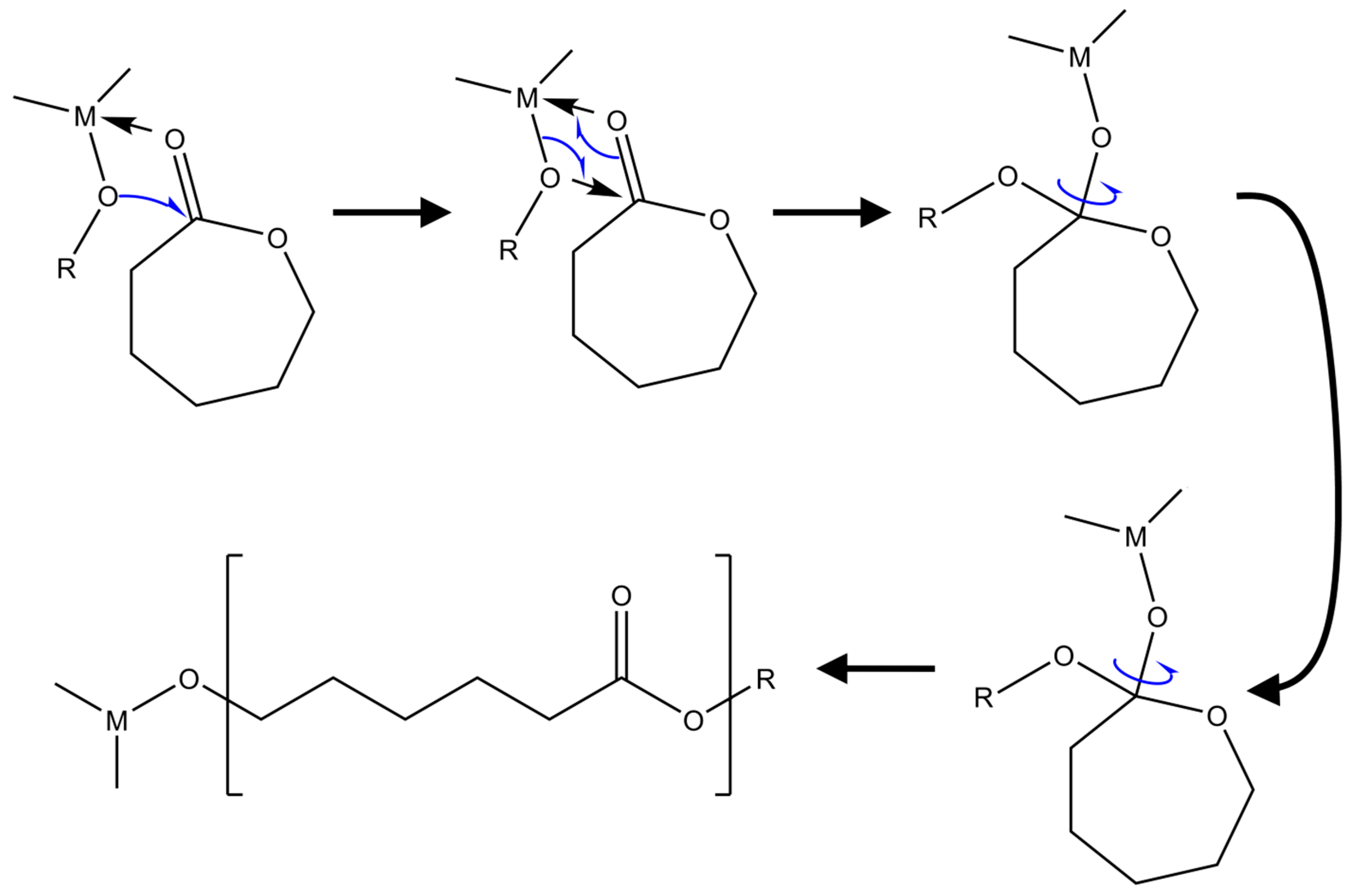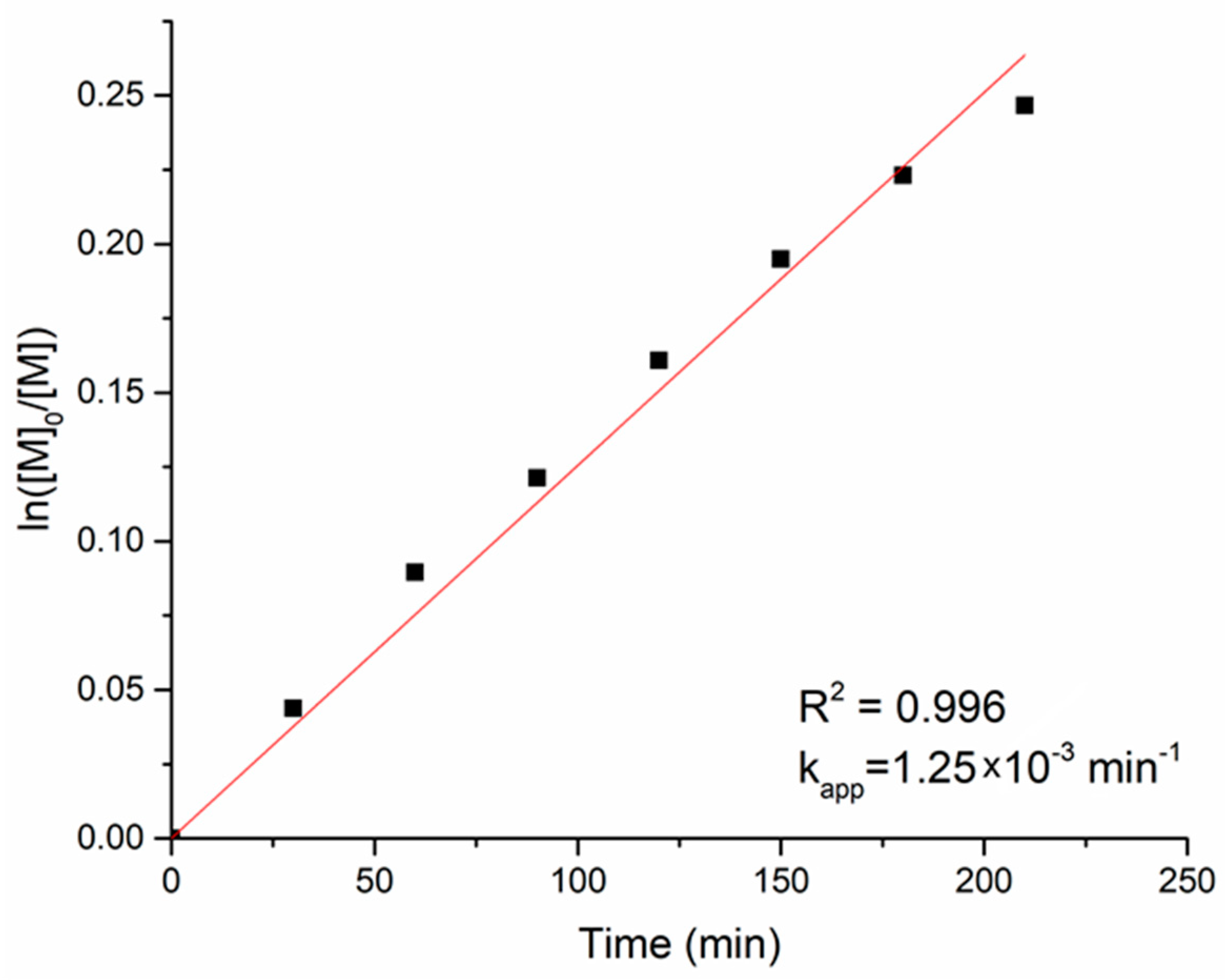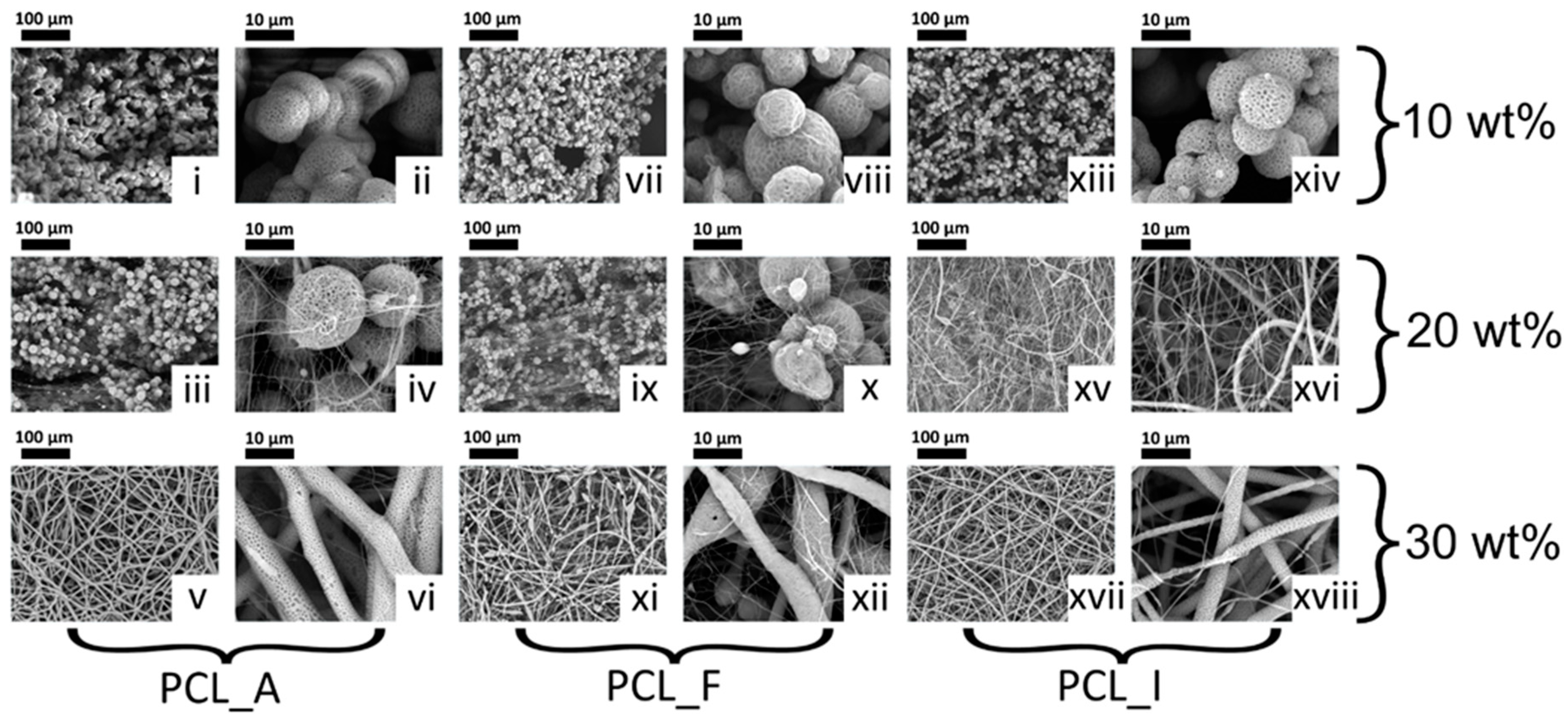Synthesis and Electrospinning of Polycaprolactone from an Aluminium-Based Catalyst: Influence of the Ancillary Ligand and Initiators on Catalytic Efficiency and Fibre Structure
Abstract
1. Introduction
2. Materials and Methods
3. Results and Discussion
4. Conclusions
Author Contributions
Funding
Acknowledgments
Conflicts of Interest
References
- Sun, H.; Kabb, C.P.; Sims, M.B.; Sumerlin, B.S. Architecture-transformable polymers: Reshaping the future of stimuli-responsive polymers. Prog. Polym. Sci. 2019, 89, 61–75. [Google Scholar] [CrossRef]
- Sun, H.; Kabb, C.P.; Dai, Y.; Hill, M.R.; Ghiviriga, I.; Bapat, A.P.; Sumerlin, B.S. Macromolecular metamorphosis via stimulus-induced transformations of polymer architecture. Nat. Chem. 2017, 9, 817–823. [Google Scholar] [CrossRef]
- Shi, J.; Votruba, A.R.; Farokhzad, O.C.; Langer, R. Nanotechnology in Drug Delivery and Tissue Engineering: From Discovery to Applications. Nano Lett. 2010, 10, 3223–3230. [Google Scholar] [CrossRef] [PubMed]
- Martina, M.; Hutmacher, D.W. Biodegradable polymers applied in tissue engineering research: A review. Polym. Int. 2007, 56, 145–157. [Google Scholar] [CrossRef]
- Kamaly, N.; Yameen, B.; Wu, J.; Farokhzad, O.C. Degradable Controlled-Release Polymers and Polymeric Nanoparticles: Mechanisms of Controlling Drug Release. Chem. Rev. 2016, 116, 2602–2663. [Google Scholar] [CrossRef]
- Woodruff, M.A.; Hutmacher, D.W. The return of a forgotten polymer—Polycaprolactone in the 21st century. Prog. Polym. Sci. 2010, 35, 1217–1256. [Google Scholar] [CrossRef]
- Labet, M.; Thielemans, W. Synthesis of polycaprolactone: A review. Chem. Soc. Rev. 2009, 38, 3484–3504. [Google Scholar] [CrossRef]
- Ahamed, M.; Akhtar, M.J.; Majeed Khan, M.A.; Alhadlaq, H.A. Oxidative stress mediated cytotoxicity of tin (IV) oxide (SnO2) nanoparticles in human breast cancer (MCF-7) cells. Colloids Surf. B Biointerfaces 2018, 172, 152–160. [Google Scholar] [CrossRef]
- Ganguly (Ghosh), B.B.; Talukdar, G.; Sharma, A. Cytotoxicity of tin on human peripheral lymphocytes in vitro. Mutat. Res. Lett. 1992, 282, 61–67. [Google Scholar] [CrossRef]
- Hamitou, A.; Ouhadi, T.; Jerome, R.; Teyssié, P. Soluble bimetallic μ-oxoalkoxides. VII. Characteristics and mechanism of ring-opening polymerization of lactones. J. Polym. Sci. Polym. Chem. Ed. 1977, 15, 865–873. [Google Scholar] [CrossRef]
- Takami, Y.; Nakazawa, T.; Makinouchi, K.; Glueck, J.; Nosé, Y. Biocompatibility of alumina ceramic and polyethylene as materials for pivot bearings of a centrifugal blood pump. J. Biomed. Mater. Res. 1997, 36, 381–386. [Google Scholar] [CrossRef]
- Ronca, A.; Ronca, S.; Forte, G.; Zeppetelli, S.; Gloria, A.; De Santis, R.; Ambrosio, L. Synthesis and characterization of divinyl-fumarate poly-ε-caprolactone for scaffolds with controlled architectures. J. Tissue Eng. Regen. Med. 2018, 12, e523–e531. [Google Scholar] [CrossRef]
- Akatsuka, M.; Aida, T.; Inoue, S. Alcohol/methylaluminum diphenolate systems as novel, versatile initiators for synthesis of narrow molecular weight distribution polyester and polycarbonate. Macromolecules 1995, 28, 1320–1322. [Google Scholar] [CrossRef]
- Zhang, W.; Ronca, S.; Mele, E. Electrospun Nanofibres Containing Antimicrobial Plant Extracts. Nanomaterials 2017, 7, 42. [Google Scholar] [CrossRef]
- Wu, J.; Wang, N.; Zhao, Y.; Jiang, L. Electrospinning of multilevel structured functional micro-/nanofibers and their applications. J. Mater. Chem. A 2013, 1, 7290. [Google Scholar] [CrossRef]
- Zhang, W.; Mele, E. Phase separation events induce the coexistence of distinct nanofeatures in electrospun fibres of poly(ethyl cyanoacrylate) and polycaprolactone. Mater. Today Commun. 2018, 16, 135–141. [Google Scholar] [CrossRef]
- Huang, C.; Thomas, N.L. Fabricating porous poly(lactic acid) fibres via electrospinning. Eur. Polym. J. 2018, 99, 464–476. [Google Scholar] [CrossRef]
- Nezarati, R.M.; Eifert, M.B.; Cosgriff-Hernandez, E. Effects of Humidity and Solution Viscosity on Electrospun Fiber Morphology. Tissue Eng. Part C Methods 2013, 19, 810–819. [Google Scholar] [CrossRef]
- Pant, H.R.; Neupane, M.P.; Pant, B.; Panthi, G.; Oh, H.-J.; Lee, M.H.; Kim, H.Y. Fabrication of highly porous poly (ε-caprolactone) fibers for novel tissue scaffold via water-bath electrospinning. Colloids Surf. B Biointerfaces 2011, 88, 587–592. [Google Scholar] [CrossRef]
- Katsogiannis, K.A.G.; Vladisavljević, G.T.; Georgiadou, S. Porous electrospun polycaprolactone (PCL) fibres by phase separation. Eur. Polym. J. 2015, 69, 284–295. [Google Scholar] [CrossRef]
- Khambatta, F.B.; Warner, F.; Russell, T.; Stein, R.S. Small-angle X-ray and light scattering studies of the morphology of blends of poly(ε-caprolactone) with poly(vinyl chloride). J. Polym. Sci. Polym. Phys. Ed. 1976, 14, 1391–1424. [Google Scholar] [CrossRef]
- Bohdanecký, M.; Tuzar, Z. Unperturbed dimensions of the molecules of poly-ε-caprolactam. Collect. Czechoslov. Chem. Commun. 1969, 34, 2589–2597. [Google Scholar] [CrossRef]
- Desbief, S.; Grignard, B.; Detrembleur, C.; Rioboo, R.; Vaillant, A.; Seveno, D.; Voué, M.; De Coninck, J.; Jonas, A.M.; Jérôme, C.; et al. Superhydrophobic Aluminum Surfaces by Deposition of Micelles of Fluorinated Block Copolymers. Langmuir 2010, 26, 2057–2067. [Google Scholar] [CrossRef]
- Dikić, T.; Ming, W.; van Benthem, R.A.T.M.; Esteves, A.C.C.; de With, G. Self-Replenishing Surfaces. Adv. Mater. 2012, 24, 3701–3704. [Google Scholar] [CrossRef]
- Xie, C.; Zhang, P.; Zhang, Z.; Yang, C.; Zhang, J.; Wu, W.; Jiang, X. Drug-loaded pseudo-block copolymer micelles with a multi-armed star polymer as the micellar exterior. Nanoscale 2015, 7, 12572–12580. [Google Scholar] [CrossRef]
- Hsueh, M.-L.; Huang, B.-H.; Lin, C.-C. Reactions of 2,2′-(2-Methoxybenzylidene)bis(4-methyl-6-tert-butylphenol) with Trimethylaluminum: Novel Efficient Catalysts for “Living” and “Immortal” Polymerization of ε-Caprolactone. Macromolecules 2002, 35, 5763–5768. [Google Scholar] [CrossRef]
- Ko, B.-T.; Lin, C.-C. Efficient “Living” and “Immortal” Polymerization of Lactones and Diblock Copolymer of ε-CL and δ-VL Catalyzed by Aluminum Alkoxides. Macromolecules 1999, 32, 8296–8300. [Google Scholar] [CrossRef]
- Brintzinger, H.H.; Fischer, D.; Mülhaupt, R.; Rieger, B.; Waymouth, R.M. Stereospecific Olefin Polymerization with Chiral Metallocene Catalysts. Angew. Chem. Int. Ed. 1995, 34, 1143–1170. [Google Scholar] [CrossRef]
- Dubois, P.; Ropson, N.; Jérôme, R.; Teyssié, P. Macromolecular Engineering of Polylactones and Polylactides. 19. Kinetics of Ring-Opening Polymerization of ε-Caprolactone Initiated with Functional Aluminum Alkoxides. Macromolecules 1996, 29, 1965–1975. [Google Scholar] [CrossRef]
- Jiang, S.; Ji, X.; An, L.; Jiang, B. Crystallization behavior of PCL in hybrid confined environment. Polymer 2001, 42, 3901–3907. [Google Scholar] [CrossRef]
- Casper, C.L.; Stephens, J.S.; Tassi, N.G.; Chase, D.B.; Rabolt, J.F. Controlling Surface Morphology of Electrospun Polystyrene Fibers: Effect of Humidity and Molecular Weight in the Electrospinning Process. Macromolecules 2004, 37, 573–578. [Google Scholar] [CrossRef]
- Hajiali, H.; Summa, M.; Russo, D.; Armirotti, A.; Brunetti, V.; Bertorelli, R.; Athanassiou, A.; Mele, E. Alginate–lavender nanofibers with antibacterial and anti-inflammatory activity to effectively promote burn healing. J. Mater. Chem. B 2016, 4, 1686–1695. [Google Scholar] [CrossRef]
- Zhang, W.; Huang, C.; Kusmartseva, O.; Thomas, N.L.; Mele, E. Electrospinning of polylactic acid fibres containing tea tree and manuka oil. React. Funct. Polym. 2017, 117, 106–111. [Google Scholar] [CrossRef]
- Reshmi, C.R.; Sundaran, S.P.; Juraij, A.; Athiyanathil, S. Fabrication of superhydrophobic polycaprolactone/beeswax electrospun membranes for high-efficiency oil/water separation. RSC Adv. 2017, 7, 2092–2102. [Google Scholar]








| Time (min) | Mn (g mol−1) | Mw (g mol−1) | PDI | ε-CL Conversion (%) | Theoretical Mw (g mol−1) |
|---|---|---|---|---|---|
| 30 | 2106 | 2481 | 1.178 | 4 | 2200 |
| 60 | 4051 | 4662 | 1.151 | 8 | 4300 |
| 90 | 5646 | 6411 | 1.135 | 11 | 6000 |
| 120 | 7120 | 8101 | 1.138 | 15 | 8100 |
| 150 | 8459 | 9467 | 1.119 | 18 | 9700 |
| 180 | 9547 | 10,765 | 1.128 | 22 | 11,900 |
| 210 | 10,688 | 11,782 | 1.102 | 25 | 13,500 |
| Sample | Al-MDBP-In b (mmol) | CL (mol) | CL:Al | Conv. (%) | Yield (g) | Mn (kg/mol) | Mw (kg/mol) | Al* c (mmol) | PDI |
|---|---|---|---|---|---|---|---|---|---|
| PCL_A | 0.37 | 0.355 | 960:1 | 23 | 9 | 17 | 20 | ~0.4 | 1.14 |
| PCL_F | 0.74 | 0.176 | 240:1 | 40 | 8 | 18 | 21 | ~0.4 | 1.12 |
| PCL_I | 0.74 | 0.176 | 240:1 | ~100 | 20 | 22 | 27 | ~0.7 | 1.19 |
| Sample | Tm1 (°C) | Tc (°C) | ΔHm1 (J/g) | Xc % |
|---|---|---|---|---|
| PCL_A | 57.2 | 36.4 | 92 | 67.8 |
| PCL_F | 62.7 | 35.7 | 105.2 | 77.6 |
| PCL_I | 61.9 | 34.1 | 102.7 | 75.7 |
| Sample | Water Contact Angle (°) |
|---|---|
| PCL_A | 131.9 ± 1.0 |
| PCL_F | 137.6 ± 1.3 |
| PCL_I | 129.6 ± 3.7 |
© 2019 by the authors. Licensee MDPI, Basel, Switzerland. This article is an open access article distributed under the terms and conditions of the Creative Commons Attribution (CC BY) license (http://creativecommons.org/licenses/by/4.0/).
Share and Cite
Kouparitsas, I.K.; Mele, E.; Ronca, S. Synthesis and Electrospinning of Polycaprolactone from an Aluminium-Based Catalyst: Influence of the Ancillary Ligand and Initiators on Catalytic Efficiency and Fibre Structure. Polymers 2019, 11, 677. https://doi.org/10.3390/polym11040677
Kouparitsas IK, Mele E, Ronca S. Synthesis and Electrospinning of Polycaprolactone from an Aluminium-Based Catalyst: Influence of the Ancillary Ligand and Initiators on Catalytic Efficiency and Fibre Structure. Polymers. 2019; 11(4):677. https://doi.org/10.3390/polym11040677
Chicago/Turabian StyleKouparitsas, Ioannis K., Elisa Mele, and Sara Ronca. 2019. "Synthesis and Electrospinning of Polycaprolactone from an Aluminium-Based Catalyst: Influence of the Ancillary Ligand and Initiators on Catalytic Efficiency and Fibre Structure" Polymers 11, no. 4: 677. https://doi.org/10.3390/polym11040677
APA StyleKouparitsas, I. K., Mele, E., & Ronca, S. (2019). Synthesis and Electrospinning of Polycaprolactone from an Aluminium-Based Catalyst: Influence of the Ancillary Ligand and Initiators on Catalytic Efficiency and Fibre Structure. Polymers, 11(4), 677. https://doi.org/10.3390/polym11040677







